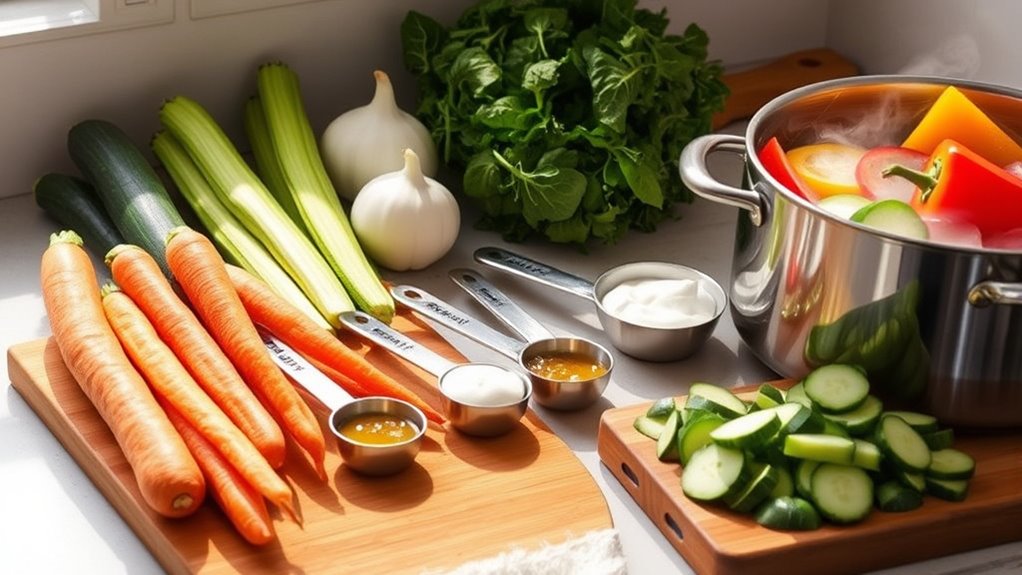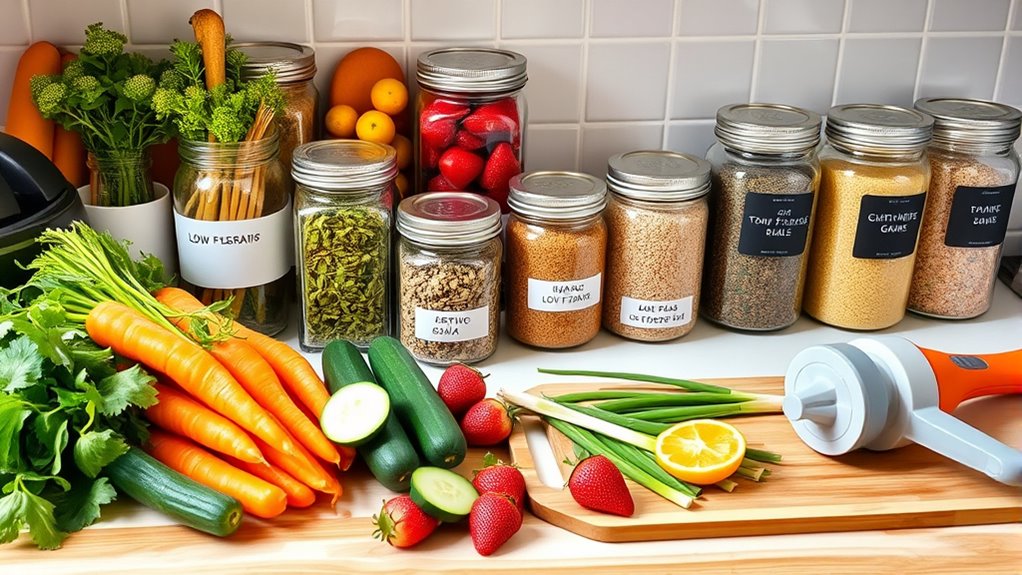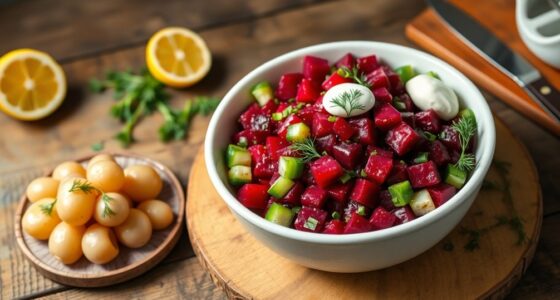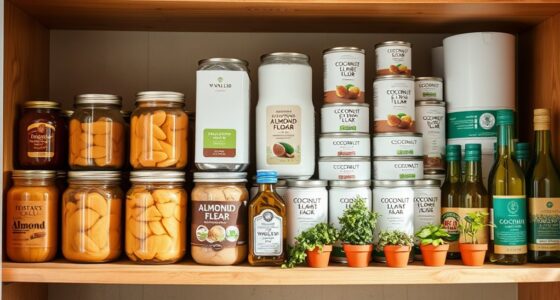To cook low-FODMAP meals, focus on selecting ingredients like specific vegetables, lean proteins, and gluten-free grains that are known to be easier on digestion. Pay close attention to labels to avoid hidden FODMAPs, and prepare produce by washing and peeling to reduce triggers. Flavor dishes with herbs and spices that are safe, and use garlic-infused oil instead of garlic powder. Following these guidelines helps manage symptoms while enjoying tasty meals—continue exploring to discover more helpful tips.
Key Takeaways
- Use low-FODMAP ingredients like specific vegetables, proteins, and grains, and watch portion sizes to minimize digestive discomfort.
- Properly wash, peel, and prepare produce to reduce FODMAP content and improve digestion.
- Read labels carefully to identify hidden FODMAP ingredients such as garlic, onion, and wheat.
- Flavor dishes with herbs, spices, and garlic-infused oils, avoiding high-FODMAP powders and extracts.
- Plan balanced meals with appropriate portions to manage symptoms and support digestive health.
Understanding FODMAPs and Their Impact on Digestion

FODMAPs are a group of short-chain carbohydrates found in many common foods that can cause digestive discomfort in some people. When you consume high-FODMAP foods, your gut bacteria ferment these carbs, producing gas and drawing water into your intestines. This process can lead to symptoms like bloating, cramps, diarrhea, or constipation. Not everyone reacts to FODMAPs, but if you notice digestive issues after eating certain foods, they might be the culprits. Understanding which foods contain FODMAPs helps you make better choices and manage symptoms. Cutting back on high-FODMAP foods can markedly improve your comfort and digestion. Remember, the goal isn’t to eliminate all carbs but to identify and moderate the ones that trigger your symptoms. Recognizing the best foods for FODMAP management can further support your digestive health. Being aware of digestive responses to certain foods can help tailor your diet effectively. Incorporating personalized dietary strategies based on your reactions can enhance your overall well-being.
Key Ingredients for Low-FODMAP Cooking

When cooking low-FODMAP meals, choosing the right ingredients is essential. Focus on low-FODMAP vegetables, suitable protein sources, and herbs or spices that add flavor without causing discomfort. These key ingredients help you create tasty, digestion-friendly dishes. For those interested in enhancing their bikes, various electric bike conversion kits offer reliable performance and compatibility options. Incorporating wicks made from safe, natural materials can also improve the burning quality of homemade candles, ensuring a cleaner and healthier burn.
Low-FODMAP Vegetables
Are you looking for vegetables that fit seamlessly into a low-FODMAP diet? You’re in luck! There are many options that add flavor and nutrition without upsetting your digestive system. Here are three top choices:
- Zucchini—versatile and mild, perfect for stir-fries or grilling.
- Spinach—packed with nutrients and great for salads or sautés.
- Carrots—sweet, crunchy, and suitable for roasting or raw snacks.
These vegetables are low in FODMAPs and easy to incorporate into your meals. Remember to stick to recommended serving sizes to avoid any issues. By choosing these vegetables, you’ll keep your dishes flavorful while supporting your digestive health. Incorporating sound healing science principles, such as mindful preparation and presentation, can enhance your overall eating experience. Being aware of fermentation processes can also help you avoid unintended FODMAP increases in your meals. Additionally, selecting fresh, unprocessed produce can help minimize hidden FODMAPs that may be present in some packaged foods. Maintaining awareness of gut health strategies can further optimize your dietary choices. Incorporating proper food storage techniques can prevent nutrient loss and contamination. Keep experimenting with different combinations to keep your meals exciting!
Suitable Protein Sources
Choosing the right protein sources is key to maintaining a satisfying and digestive-friendly low-FODMAP meal. Lean options like chicken, turkey, and eggs are reliable choices. Fish such as salmon, tuna, and cod provide healthy fats and are naturally low in FODMAPs. Firm tofu and tempeh are suitable plant-based proteins if prepared properly. To help visualize, here’s a quick guide:
| Protein Type | Examples | Preparation Tips |
|---|---|---|
| Poultry | Chicken, Turkey | Grill, bake, or poach |
| Seafood | Salmon, Tuna | Grill, bake, or poach |
| Plant-based | Tofu, Tempeh | Marinate and stir-fry |
Choosing these options guarantees you receive satisfying protein without upsetting your digestion.
Flavorful Herbs & Spices
In low-FODMAP cooking, herbs and spices play a crucial role in adding vibrant flavor without relying on ingredients that may cause digestive discomfort. You can confidently enhance your dishes by choosing the right herbs and spices. Here are three tips to get started:
- Use fresh herbs like basil, cilantro, and chives to brighten flavors without increasing FODMAPs.
- Incorporate dried spices such as cumin, paprika, and turmeric for depth and warmth.
- Limit onion and garlic powders, opting instead for infusions like garlic-infused oil to add aroma without FODMAP triggers.
- Understanding the history of pinball machines can inspire creative ways to incorporate playful and nostalgic themes into your culinary presentation, making your meals both flavorful and fun.
- Properly storing and handling herbs and spices can help preserve their flavor and potency, ensuring your dishes remain tasty and aromatic over time. Additionally, experimenting with herb and spice combinations can elevate your low-FODMAP dishes by creating complex and satisfying flavor profiles. Incorporating knowledge from cultural influences can further diversify your meal options and introduce new, exciting flavors to your cooking repertoire.
- Being aware of seasonal variations can help you choose the freshest herbs and spices, enhancing your cooking’s overall flavor and freshness.
Experimenting with these options helps you create delicious, gut-friendly meals that are full of flavor and satisfying. Remember, herbs and spices are your best friends in low-FODMAP cooking!
Reading Labels and Identifying Hidden FODMAPs

Ever wonder how to spot hidden FODMAPs on food labels? The key is reading ingredients carefully. Look out for common high-FODMAP ingredients like garlic, onion, wheat, and certain sweeteners such as honey or high-fructose corn syrup. Even if these aren’t listed plainly, they might appear under less obvious names—like onion powder or garlic extract. Check the nutrition facts for serving sizes, as small amounts might be okay, but larger portions could contain problematic ingredients. Be cautious with processed foods, sauces, and dressings—they often contain hidden FODMAPs. When in doubt, research unfamiliar ingredients or choose products labeled “low-FODMAP” to ensure they’re safe for your diet. Incorporating label reading techniques can help you better understand and identify potential FODMAP sources in your diet. Developing a mindful approach to ingredient lists enhances your ability to manage spiritual energy and maintain overall well-being.
Techniques for Preparing Low-FODMAP Vegetables and Fruits

To prepare low-FODMAP vegetables and fruits, start by choosing produce labeled as safe or verified low-FODMAP options. Make sure to wash them thoroughly to remove any residues, and consider peeling or trimming as needed to reduce FODMAP content. Proper preparation helps guarantee your meals stay gentle on your digestive system while maintaining flavor and texture. Additionally, understanding best practices for food prep can further optimize the FODMAP content in your dishes.
Selecting Low-FODMAP Produce
Wondering how to choose the best produce for a low-FODMAP diet? Focus on selecting fruits and vegetables that are naturally low in fermentable carbs. To make it easier, keep these tips in mind:
- Look for produce labeled as low-FODMAP or check a reliable guide for approved options.
- Opt for small portions, as some foods are low FODMAP in moderation but high in larger quantities.
- Prioritize fresh, seasonal produce to guarantee maximum ripeness and flavor.
- Understanding color accuracy in produce can help identify ripe, flavorful options that are more likely to be low in FODMAPs.
Proper Washing Techniques
Proper washing is essential for preparing low-FODMAP fruits and vegetables safely. It removes dirt, bacteria, and potential residues that could affect digestion. To wash effectively, rinse produce under cold running water, gently rubbing surfaces with your hands or a soft brush. For leafy greens, separate leaves and wash thoroughly. Use the following table as a quick reference:
| Produce Type | Washing Method | Key Tips |
|---|---|---|
| Fruits | Rinse under water | Dry with a clean towel |
| Leafy Greens | Separate and rinse | Use a brush for stems |
| Root Vegetables | Scrub with a brush | Rinse thoroughly |
Taking these steps ensures your produce is clean and safe, reducing FODMAP-related discomfort and preparing you for healthy cooking. Additionally, electric bike technology can be used to power small kitchen appliances, highlighting sustainable energy practices. Incorporating proper produce handling techniques can further improve safety and freshness during food preparation, especially by minimizing cross-contamination. Understanding zoning regulations can also assist in planning a suitable space for food prep areas, ensuring compliance and efficiency. Using appropriate storage options, like a reliable Dometic fridge, can help maintain produce freshness and reduce spoilage.
Peeling and Preparation Tips
Peeling and preparing low-FODMAP fruits and vegetables can substantially reduce their FODMAP content and improve digestion. To get the best results, follow these tips:
- Remove skins from high-FODMAP produce like apples, peaches, and onions to lower their FODMAP levels.
- Use a sharp peeler or knife to carefully peel fruits and vegetables, avoiding unnecessary waste.
- Cut produce into small, uniform pieces to ensure even cooking and easier digestion.
- Consider using self-watering plant pots to maintain optimal moisture levels for healthy plant growth, which can help produce better quality fruits and vegetables.
Choosing the Right Proteins and Grains

Choosing the right proteins and grains is essential for maintaining a low-FODMAP diet while ensuring your meals are satisfying and nutritious. Focus on lean options like eggs, chicken, turkey, and firm tofu, which are naturally low in FODMAPs. For grains, select gluten-free options such as rice, quinoa, oats, or corn-based products, as they are typically well-tolerated. Be cautious with portion sizes—overconsumption can trigger symptoms. Avoid high-FODMAP proteins like certain legumes, processed meats, and fish with added ingredients. When shopping, read labels carefully to check for added fillers or preservatives that may contain FODMAPs. Incorporating these safe choices will help you build balanced meals that support your digestive health while satisfying your taste buds.
Flavoring and Seasoning Without Triggering FODMAPs

Once you’ve selected low-FODMAP proteins and grains, adding flavor is key to making your meals enjoyable. To season safely, focus on herbs and spices that are low in FODMAPs. Here are three ways to enhance flavor:
- Use fresh herbs like basil, cilantro, and parsley for brightness.
- Incorporate spices such as turmeric, cumin, and ginger for warmth and depth.
- Add citrus zest or juice for a tangy kick without FODMAP concerns.
Avoid traditional onion and garlic powders, which are high in FODMAPs, but consider garlic-infused oils to get that familiar flavor. Experimenting with these options helps you create delicious, satisfying dishes while keeping symptoms in check. Remember, small amounts often make a big difference in taste!
Meal Planning and Portion Sizes for Symptom Management

Effective meal planning and appropriate portion sizes are essential for managing low-FODMAP symptoms. By organizing your meals ahead of time, you can guarantee you stick to safe ingredients and avoid accidental triggers. Focus on balancing your plate with low-FODMAP vegetables, proteins, and grains, while keeping portion sizes in check. Use measuring cups and a food scale to maintain consistency, as even small amounts of high-FODMAP foods can cause symptoms. Pay attention to serving sizes listed in the Monash app or reliable resources, and don’t forget to spread your meals evenly throughout the day to prevent overloading your digestive system. Planning ahead helps you enjoy safe, satisfying meals without the worry of symptom flare-ups.
Simple Low-FODMAP Recipes to Get Started

Getting comfortable with low-FODMAP cooking starts with simple recipes that are easy to prepare and delicious. Start with staples like grilled chicken, rice bowls, or vegetable stir-fries. These dishes are straightforward and adaptable to your preferences. To help you get started, here are three easy recipes:
- Grilled Lemon Herb Chicken – marinate chicken with low-FODMAP herbs and lemon juice.
- Quinoa and Roasted Veggie Bowl – toss low-FODMAP vegetables with olive oil and roast.
- Low-FODMAP Vegetable Stir-Fry – sauté bell peppers, carrots, and spinach with ginger and soy sauce.
These recipes build confidence and introduce you to flavor combinations that fit your diet. Once you’re comfortable, you can experiment and customize them to suit your taste.
Tips for Dining Out and Eating on the Go

Exploring dining out and eating on the go with a low-FODMAP diet can seem challenging, but with some strategic planning, it becomes much easier. Before heading out, research restaurants that offer low-FODMAP options or are willing to customize dishes. Don’t hesitate to ask questions about ingredients, cooking methods, and portion sizes. Stick to simple, plain foods like grilled meats, salads (without onion or garlic), and steamed vegetables. Carry portable snacks such as low-FODMAP certified bars or nuts to avoid unnecessary temptations. When ordering, specify your dietary needs clearly and request modifications if needed. Planning ahead helps you stay in control and enjoy your meals without stress. With these tips, you can dine out confidently while managing your low-FODMAP lifestyle.
Frequently Asked Questions
Are There Any Low-Fodmap Substitutes for Common High-Fodmap Ingredients?
You might wonder if there are low-FODMAP substitutes for high-FODMAP ingredients. Luckily, many options exist: replace onions with green parts of scallions, use garlic-infused oil instead of garlic, and swap wheat flour for rice or gluten-free alternatives. You can also try lactose-free dairy or plant-based options. These substitutions help you enjoy your favorite dishes while keeping your FODMAP intake in check.
How Can I Adapt Traditional Recipes to Be Low-Fodmap?
Think of adapting recipes as transforming a familiar song into a new melody. You can swap high-FODMAP ingredients for gentle, low-FODMAP ones—like using garlic-infused oil instead of garlic or lactose-free dairy. Focus on fresh herbs, spices, and alternative grains. Adjust cooking methods if needed, and keep flavors vibrant. With a little creativity, your favorite dishes can stay comforting while being gentle on your digestion.
Can I Freeze Low-Fodmap Meals for Convenience?
Yes, you can freeze low-FODMAP meals for convenience. Just let the dishes cool completely before storing them in airtight containers or freezer bags. Label each with the date and ingredients. Most low-FODMAP cooked meals, like soups, stews, and casseroles, freeze well and retain flavor. When you’re ready to eat, thaw in the fridge overnight and reheat thoroughly. Freezing helps you save time and stay on track with your diet.
Are There Specific Cooking Utensils to Avoid Cross-Contamination?
You should avoid using the same utensils for high-FODMAP ingredients and low-FODMAP meals to prevent cross-contamination. Use separate cutting boards, knives, and spatulas, ideally labeled or color-coded. Wash utensils thoroughly with hot, soapy water between uses. Keeping dedicated utensils for low-FODMAP cooking helps maintain your diet’s integrity and minimizes the risk of triggering symptoms. Always practice mindful utensil management for safe, effective meal prep.
How Do I Handle Dining Out When Unsure About FODMAP Content?
Imagine steering a maze with a flickering lantern—dining out can feel uncertain when FODMAP details aren’t clear. You should ask the staff about ingredients and preparation methods, and choose dishes with simple, recognizable components. Look for restaurants that cater to special diets or have allergy-friendly menus. Trust your instincts, and don’t hesitate to customize orders—your health is the guiding light through this culinary maze.
Conclusion
Mastering low-FODMAP cooking is like tuning a delicate instrument—you’ll find the perfect harmony between flavor and comfort. With practice, your kitchen becomes a sanctuary where gut-friendly meals bloom like a well-tended garden. Trust your senses, read labels like a detective, and season wisely. Soon, cooking low-FODMAP will feel as natural as breathing, turning your daily meals into a symphony of nourishment that keeps symptoms at bay and joy at the forefront.









